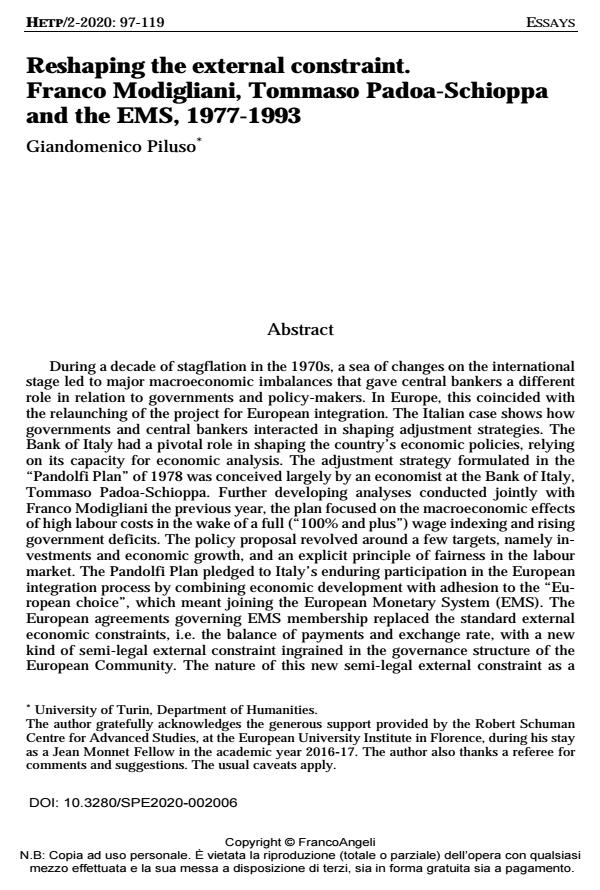Reshaping the external constraint. Franco Modigliani, Tommaso Padoa-Schioppa and the EMS, 1977-1993
Titolo Rivista HISTORY OF ECONOMIC THOUGHT AND POLICY
Autori/Curatori Giandomenico Piluso
Anno di pubblicazione 2021 Fascicolo 2020/2
Lingua Inglese Numero pagine 23 P. 97-119 Dimensione file 128 KB
DOI 10.3280/SPE2020-002006
Il DOI è il codice a barre della proprietà intellettuale: per saperne di più
clicca qui
Qui sotto puoi vedere in anteprima la prima pagina di questo articolo.
Se questo articolo ti interessa, lo puoi acquistare (e scaricare in formato pdf) seguendo le facili indicazioni per acquistare il download credit. Acquista Download Credits per scaricare questo Articolo in formato PDF

FrancoAngeli è membro della Publishers International Linking Association, Inc (PILA)associazione indipendente e non profit per facilitare (attraverso i servizi tecnologici implementati da CrossRef.org) l’accesso degli studiosi ai contenuti digitali nelle pubblicazioni professionali e scientifiche
During a decade of stagflation in the 1970s, a sea of changes on the interna-tional stage led to major macroeconomic imbalances that gave central bankers a different role in relation to governments and policy-makers. In Europe, this coin-cided with the relaunching of the project for European integration. The Italian case shows how governments and central bankers interacted in shaping adjustment strategies. The Bank of Italy had a pivotal role in shaping the country’s economic policies, relying on its capacity for economic analysis. The adjustment strategy formulated in the "Pandolfi Plan" of 1978 was conceived largely by an economist at the Bank of Italy, Tommaso Padoa-Schioppa. Further developing analyses conducted jointly with Franco Modigliani the previous year, the plan focused on the macroeconomic effects of high labour costs in the wake of a full ("100% and plus") wage indexing and rising government deficits. The policy proposal revolved around a few targets, namely investments and economic growth, and an explicit principle of fairness in the labour market. The Pandolfi Plan pledged to Italy’s en-during participation in the European integration process by combining economic development with adhesion to the "European choice", which meant joining the European Monetary System (EMS). The European agreements governing EMS membership replaced the standard external economic constraints, i.e. the balance of payments and exchange rate, with a new kind of semi-legal external constraint ingrained in the governance structure of the European Community. The nature of this new semi-legal external constraint as a fiscal discipline mechanism eventually emerged more clearly with the Maastricht Treaty.
Parole chiave:European Monetary System-EMS, Franco Modigliani, Tommaso Padoa-Schioppa, external constraints, Keynesian economics, Ordoliberalism, optimal currency area
Jel codes: A11, B31, E42, E58, F15, F33, H12, H6, J08
- Franco Modigliani and Ezio Tarantelli on Wage Moderation and Political Exchange: A Lesson to Be Learned in the New Age of Inflation Giuseppe Ciccarone, Giovanni Di Bartolomeo, in History of Political Economy 12303256/2025
DOI: 10.1215/00182702-12303256
Giandomenico Piluso, Reshaping the external constraint. Franco Modigliani, Tommaso Padoa-Schioppa and the EMS, 1977-1993 in "HISTORY OF ECONOMIC THOUGHT AND POLICY" 2/2020, pp 97-119, DOI: 10.3280/SPE2020-002006